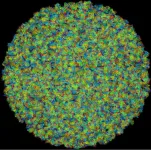(Press-News.org) A new machine-learning system developed at the University of Alaska Fairbanks can automatically produce detailed maps from satellite data to show locations of likely beetle-killed spruce trees in Alaska, even in forests of low and moderate infestation where identification is otherwise difficult.
The automated process can help forestry and wildfire managers in their decisions. That’s critical as the beetle infestation spreads.
The Alaska Division of Forestry and Fire Protection calls the spruce beetle “the most damaging insect in Alaska’s forests.”
The identification system by assistant professor Simon Zwieback at the UAF Geophysical Institute was detailed in the ISPRS Journal of Photogrammetry and Remote Sensing on May 18. Zwieback is also affiliated with the UAF College of Natural Science and Mathematics.
The work fills a knowledge gap: how to automatically map likely spruce beetle infestations in areas of low to moderate severity.
“We lack comprehensive statewide maps of beetle-killed trees because existing products largely rely on expert observations from airplanes, which are expensive and restricted in space and time,” Zwieback said. “This limits stakeholders’ ability to respond to the ongoing outbreak.”
Alaska foresters now use survey flights, time-consuming manual interpretation of high-resolution imagery and automated analysis of coarser satellite imagery to find dead spruce in mixed forests. Coarser imagery can be used to identify entire stands of dead trees but not individual dead trees.
None of those identification methods, including Zwieback’s, can determine the cause of an individual tree’s death. The likelihood of beetle infestation is surmised because of its well-known presence and the damage already caused.
Zwieback’s method combines the efficiency of automation with the detail of high-resolution satellite images.
“Using machine learning and high-resolution imagery is the way to go in mixed forests,” Zwieback said.
Machine learning is a type of artificial intelligence that focuses on developing algorithms and statistical models that enable computers to learn from and make predictions or decisions based on data.
Zwieback’s machine-learning algorithm is trained using known locations of dead spruce trees. During training, the algorithm learns to recognize dead spruce based on their characteristic shape and color, and contextual clues such as shadows. Once satisfactorily trained, it can rapidly and automatically identify dead spruce trees.
Zwieback tested the method on images of an approximately 167-acre study area west of a line from Talkeetna to Byers Lake. Forested regions of the study area consist of mixed stands of spruce and birch.
The region has been heavily affected by a beetle infestation that began in the mid-2010s.
Zwieback’s method succeeded in identifying dead spruce in stands containing only a few dead trees.
Statewide, the infestation has affected approximately 2 million acres, mostly in Southcentral Alaska, since 2016. It had spread north to Cantwell and the Alaska Range mountains by 2020.
The death of large numbers of spruce results in several ecosystem changes and related consequences: Understory vegetation can change to grasses and shrubs, and dead branches can litter the floor. All of that adds to wildfire danger by putting more fuel at ground level.
Zwieback’s method can help in decisions about fire prevention and suppression.
Decreased value of timber resources and the aesthetic deterioration of the landscape are additional concerns.
Zwieback is continuing his research.
“I would like to implement this for the entire state whenever new images come in,” he said. “Remote sensing can help us understand the outbreak dynamics and inform our response to it, especially as it migrates into the Interior.”
The work was funded by NASA EPSCoR and National Science Foundation EPSCoR, the Established Program to Stimulate Competitive Research.
Zwieback said field sites have been set up on land owned by Ahtna, a Southcentral Alaska regional Native corporation, to better understand the progress and consequences of the outbreak as it moves into the Interior.
CONTACTS:
• Simon Zwieback, University of Alaska Fairbanks Geophysical Institute, 907-474-5549, szwieback@alaska.edu
• Rod Boyce, University of Alaska Fairbanks Geophysical Institute, 907-474-7185, rcboyce@alaska.edu
END
New way to spot beetle-killed spruce can help forest, wildfire managers
2024-06-13
ELSE PRESS RELEASES FROM THIS DATE:
New study reveals combined use of Donepezil and Memantine increases the probability of five-year survival of Alzheimer’s disease patients
2024-06-13
Alzheimer's disease is the world’s most common neurodegenerative disease, affecting more than 50 million people globally. Alzheimer’s disease is also among the most fatal, landing as one of the top five causes of death worldwide. However, most currently available treatments are limited to alleviating the disease’s symptoms.
Now, a new study led by Chapman University researchers has explored the efficacy of using two existing Alzheimer’s disease drugs simultaneously to reduce mortality. It is one of the largest and ...
Number of over 65s with type 1 diabetes has almost tripled in 30 years
2024-06-13
The number of people aged 65 and older with type 1 diabetes increased from 1.3 million in 1990 to 3.7 million in 2019, while death rates fell 25% from 4.7 per 100,000 population in 1990 to 3.5 in 2019, finds an analysis of data from over 200 countries and regions in The BMJ today.
Overall, the results show that more people with type 1 diabetes are living longer. However, death rates fell 13 times faster in high income countries compared with low and middle income countries, indicating that substantial ...
Brain regions that bias the brain’s response to pleasure in bipolar disorder identified
2024-06-13
Momentary shifts in mood, even those lasting just a matter of seconds, profoundly alter the brain’s response to pleasurable experiences in people with bipolar disorder, finds a new study by UCL researchers.
Previous research shows that mood can make us experience events in more positive or negative light – irrespective of having bipolar disorder. When we are in a good mood, we are drawn to viewing things more favourably – causing the good mood to rollover and gain momentum.
Equally, when we are upset we get drawn into perceiving bad outcomes as even worse, causing us to remain upset or get even more upset.
This “momentum” in mood can bias how we perceive events ...
Researchers in US, Ukraine simulate cell activity at ‘breathtaking’ timescales
2024-06-12
LAWRENCE — A partnership between scientists at the University of Kansas and collaborators in Europe, including war-torn Ukraine, will result in computer models of biological cells likely to hasten health breakthroughs by simulating molecular interactions inside cells with near experimental accuracy at vastly longer timescales than similar efforts.
The research is supported by the National Science Foundation’s IMPRESS-U (International Multilateral Partnerships for Resilient Education and Science System in Ukraine) program that aims to “support excellence in science and engineering research, education, and innovation through international collaboration and ...
NSF CAREER grant to investigate design of fluorescent protein sensors with computer simulations that may aid human health and disease
2024-06-12
DETROIT — Alice Walker, Ph.D., assistant professor of chemistry in the College of Liberal Arts and Sciences at Wayne State University, received a Faculty Early Career Development (CAREER) award from the National Science Foundation to fund her research on applying computational chemistry to the understanding and rational design of new fluorescent protein (FP) sensors.
“A sensor, chemically speaking, is a molecule that turns on or off in response to certain stimuli,” said Walker. “Proteins are good sensors because they have a florescent element; they essentially glow in the dark in response to when it touches something. ...
Study shows politicians deny misdeeds because we want to believe them
2024-06-12
Why do politicians lie and deny when they are caught up in political scandal?
According to a newly published study led by a University of Nebraska–Lincoln political scientist, the answer may be that their supporters prefer a less-than-credible denial to losing political power and in-group status because of a discredited standard-bearer.
“The driving question of our research is whether people are actually incentivizing politicians to deny wrongdoing and escape accountability,” said Pierce Ekstrom, assistant professor of political science at Nebraska.
“Certainly, there’s a very strong norm ...
Case study reveals important new details about rare second cancers related to CAR-T therapy
2024-06-12
WASHINGTON – A new detailed analysis of a patient’s second cancer after receiving CAR-T therapy for the initial cancer provides rare but important insights intended to offer helpful guidance for oncologists and pathologists about the clinical presentation and pathologic features involved in a CAR-T related second cancer.
The finding is reported June 13, 2024, in the New England Journal of Medicine.
CAR-T therapy is described by many as a new and promising treatment for blood cancers. CAR-T therapy is made from a patient’s ...
Risk of secondary cancers after CAR-T cell therapy low, according to large Stanford Medicine study
2024-06-12
A large study by researchers at Stanford Medicine has found that the risk of secondary blood cancers after CAR-T cell therapy — a cell-based cancer treatment that exploded on the scene in 2017 as a treatment for intractable blood cancers — is low, despite a Food and Drug Administration warning.
In November 2023, the FDA issued a warning about a risk of secondary cancers — particularly blood cancers — that may be associated with CAR-T cell therapy. The warning was preceded by a rising tide of ...
Mouse study identifies unique approach for preventing life-threatening complications after spinal cord injury
2024-06-12
COLUMBUS, Ohio – In response to stressful or dangerous stimuli, nerve cells in the spinal cord activate involuntary, autonomic reflexes often referred to as “fight or flight” responses.
These protective responses cause changes in blood pressure and the release of stress hormones into the blood stream. Normally, these responses are short-lived and well-controlled, but this changes after a traumatic spinal cord injury.
A first-ever study published in the journal Science Translational Research identifies a ...
Western agricultural communities need water conservation strategies to adapt to future shortages
2024-06-12
Reno, Nev. (June 12, 2024) – The Western U.S. is heavily reliant on mountain snowpacks and their gradual melt for water storage and supply, and climate change is expected to upend the reliability of this natural process. Many agricultural communities in this part of the country are examining ways to adapt to a future with less water, and new research shows that a focus on supplementing water supply by expanding reservoir capacity won’t be enough to avert future water crises.
Led by scientists at the Desert Research Institute ...




